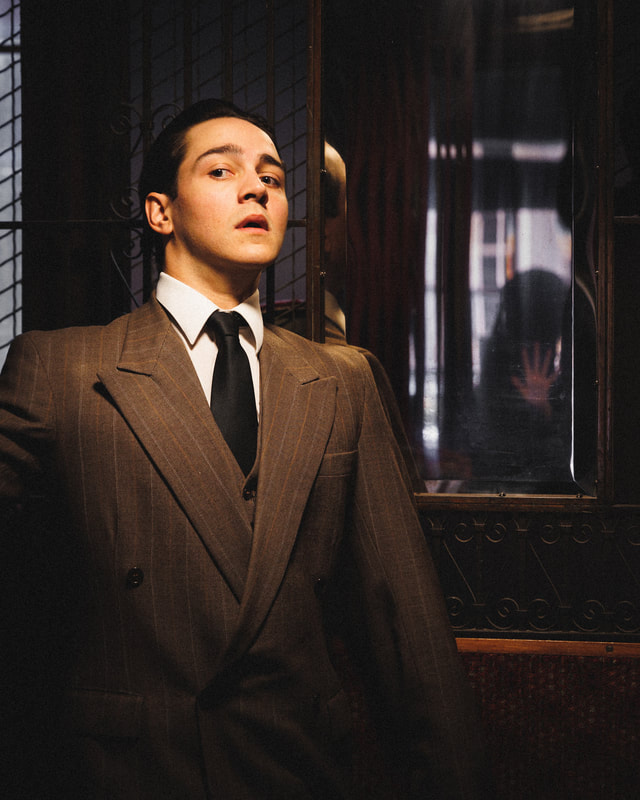Katie Hill
The set designed by Simon Boyes is sparse but effective – there is a red wash as I enter, with a few lonely chairs draped with various jackets and coats. The wall at the back seems to be painted white, but on closer inspection, it’s actually a stretched piece of textured white fabric – it’s these little details that make the technical elements of the show stand out. The use of drapery creates wonderful pockets of shadow – the coat stand on stage right which Tidy uses to transform into various characters is often left in the dark with a cold side light, I find myself mistaking it for a dark figure multiple times throughout the show.
Tidy as Arthur Kipps and Tim MacDonald as The Actor set me at ease with their well-rehearsed English accents. Arthur Kipps’s soft and erratic nature balances well with Macdonald's considered portrayal of The Actor. The blocking is tight and the small number of set pieces are successfully transformed into various items as the play demands. We follow Arthur Kipps as he hires an actor to tell his ghost story. The Actor (MacDonald) takes on the role of story Arthur and casts present Arthur as the other characters in his tale. Tidy is apt at moving between roles, applying distinct physicalities that don’t feel one-dimensional which can often be the case with such briefly encountered characters. MacDonald seems to be a methodical actor, there is a clarity and directness to his tone and movement that pulls the audience to hang on to his every word (it’s a dialogue-heavy play so props to the casting!). Tidy and MacDonald do well to play to the dryness of the script’s humour, and this is in credit to the nuance of the actors' facial expressions. As is evident in the overall quality of the production, the actor's expressions are very measured and reflect the subtleties of being fearful well.
The precise portrayal of the characters is winningly paired with the show's technical elements. With the two actors listed in the programme on stage already, I wonder how Cox will pull off the element of surprise, but he certainly does! It takes about 30 or so minutes before we get our first good scare, but Cox plays to the rule of threes and gets us all! Unfortunately, I hear the first encounter with the Woman in Black too early as my back-row seat is directly in front of the stairs to the top of the seating block. I relax a little, presuming I will be able to anticipate any further spooks – this was my first mistake. The second phase of the scare creeps out moments later on stage as the Woman in Black flickers a lantern quietly in the corners of the stage (were there multiple actors? Or was this one actor just very nimble, I’m unsure!). It’s an unnerving sight, and the audience gasps loudly, only for the same lace-dripped lady to suddenly appear in a curtain directly against the seating block – it elicits some of the loudest screams I’ve ever heard in the theatre. The lighting, designed and operated by Riley Gibson is phenomenal and suggests a theme of graveyard moonlight. It also does a brilliant job of showing the journey of the characters through muddy paths, nighttime train rides, and moonlit marshes. Meredith Dooley’s costume design compliments the lighting by keeping strictly to tones of grey and brown. The exact location of Eel Marsh – the residence of the Woman in Black – is kept relatively undefined, but this works to raise the question: what could be lurking in the corner?
A standout scene reveals a strip of the stage behind the stretched white fabric to be a graveyard. The gravestones are represented by various objects draped in cloth, and the pockets of shadow in the graveyard pull the audience further in to check for figures hiding in the folds. As the story progresses the pieces of fabric are ripped off to reveal a children’s nursery, this is a fantastically transformative moment. A special mention goes to the scene where MacDonald as Arthur traces through the house by candlelight, he holds the light close to his face, and as he runs the fast-moving shadow creates the appearance of a dark presence hanging on his shoulder. I don’t know whether this was the intention or not, but it’s a clever detail.
My biggest piece of feedback concerns the sound design (Tanya Piejus). There were a few moments of tension built carefully through silence and lighting tricks that were suddenly undercut by loud and overly complicated sound bites. The effective sound effects were those that grew slowly and never turned into any real dialogue. I wonder if those sound effects could have been created by live actors in the shadows, increasing the tension furthermore? Also, the two blackouts in the first scene or two don’t match the quality of the lighting or future transitions.
Stagecraft’s The Woman in Black is at its best when it plays to the subtleties of the horror genre. Cox, Tidy, MacDonald, the Woman in Black, and the rest of Stagecraft’s team have created a tight and exciting piece of theatre, that is quite simply a good story. Head on down to Gryphon Theatre as their season runs until the 12th of November.








